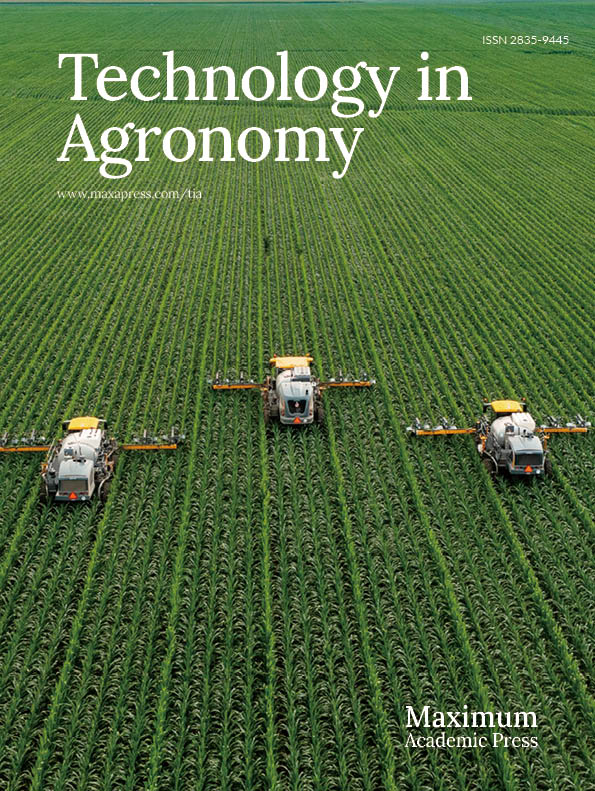-
In Brazil, in the 2022/23 harvest, beans were grown in an area of about 2.7 million hectares with an average productivity of 1.12 t ha−1[1], which is far below crops that have a high technological level or research areas. For the bean crop to reach its maximum production potential, the limiting factors must be controlled, among which competition against weeds stands out[2−5].
When weeds compete with crops, they can mobilize large amounts of nutrients and water from the soil as well as other resources from the environment, such as light, thus reducing the already insufficient resources for crops[4−7]. Weeds can release allelopathic compounds into the environment in which they occur and are also hosts for diseases and insects, leading to high losses in grain productivity[8−10] or even a reduction in the value of harvested grains at the end of the cycle, making mechanical or manual harvesting more difficult and increasing production costs and economic yield[7,8,11,12].
Since beans are cultivated almost all year round, they compete with many weed species, whether grasses or dicotyledons[6,8,13,14]. Among them, alexandergrass (Urochloa plantaginea) stands out, one of the most important weeds in the production areas of the South, Southeast, and Midwest of Brazil, causing high yield losses[3,8,15].
Alexandergrass belongs to the Poaceae family, has a C4 metabolism and exhibits rapid growth and development, making it a very competitive plant when infesting agricultural crops[3,8,16]. It is noteworthy that the critical control period for weed infestation on black beans (IPR Uirapuru cultivar), including alexandergrass, is 24 to 50 d[3], and for weed infestation on carioca beans (IPR Tangará cultivar) is 5 to 54 d after crop emergence[15]. The different critical control periods observed in the studies by Franceschetti et al.[3] and Schiessel et al.[15], are due, among other things, to the differences between the types of beans sown (black bean or carioca bean), cultivars, growth habits, cultivation management, soil characteristics, climate, species and distribution of weeds. When weeds infest crops, grain productivity can drop by up to 85% if no control method is used. The percentage loss depends on the characteristics of the weed species, the cultivars sown, the climate and soil conditions, the potential diseases, the season and the duration of coexistence or even the technology used to grow that crop[3,4,10,12,14,15]. Due to their high efficiency, practicality and low cost, chemical herbicides are the main control agents used by farmers[10,17].
Bean plants have limited ability to compete with the weed community and the degree of interference depends on the interaction between the weed and the crop, the environmental factors and the duration of coexistence[3,8,14,15]. Knowledge of the competitiveness of beans against weeds is a means of developing more sustainable management strategies, as the competitive ability of individual cultivars varies due to their different morphophysiological and genetic characteristics[8,11−13]. The competitive ability of weeds also depends on the type and density of plants in the crop's weed community as well as climate and soil characteristics[18].
There are several ways to check the competition between plants in a community. One of these is the use of the nonlinear rectangular hyperbolic equation, which relates crop productivity losses to the variables plant density, shoot dry matter, soil cover, and leaf area of weeds[8,11,19]. The selection of cultivars that are more competitive against weeds can be an integrated management strategy that can be applied to crops. For example, the crop may be more competitive in seeking environmental resources (water, light, and nutrients) in the presence of weeds[2,5,12,18], so that fewer herbicides can be used to control them, resulting in greater economic and environmental benefits.
The growth habit of beans can affect their competitiveness. More branched cultivars have better soil cover and cause less infestation of the weed community due to shading[12,20,21]. In addition, the most productive cultivars are usually those that tolerate the least competition from weeds, by directing photoassimilates to grain production to the detriment of vegetative growth[11,21,22]. In addition to higher production, there are also concerns about the level of pesticide residues in the grains. Taking into account the concept of economic damage level (EDL), the use of herbicides to control weeds that infest crops will therefore only be allowed if the damage caused by the weeds is greater than the cost of control[8,11,19].
The EDL depends on related variables such as the grain productivity of the crop, the percentage yield loss per unit of weed and the efficacy of the herbicide, in addition to economic responses such as the cost of control and the price of the harvested product[8,11,23]. Regression equations or damage functions are usually used to estimate the EDL, as these relate the productivity losses of the crop to the probable measures of weed infestation at the time of post-emergence control[8,11,23].
In this way, knowledge of the interference, the competitive ability of cultivars and the density of weeds infesting the bean crop becomes an important tool for the application of management practices, as it can serve as a basis for deciding whether or not to control the species. Against this background, the aim of the work was to evaluate the interference and determine the level of the economic damage of alexandergrass densities when competing with seven carioca-type bean cultivars.
-
The experiment was conducted from November 2019 to February 2020 at the experimental site of the Federal University of Fronteira Sul (UFFS), Campus Erechim, RS, Brazil. The site is located in the physiographic region of Alto Uruguai, Rio Grande do Sul, Brazil, at geographical coordinates 27°43'47" S latitude and 52°17'37" W longitude and at an altitude of 760 m. The soil in the experimental area is classified as typical Ferric Alumino Red Oxisol[24] and the predominant climate in the region is Cfa according to the Koppen classification, i.e. humid subtropical, with hot summers and evenly distributed rainfall. The average temperature of the warmest month is above 22 °C, the rainfall is 1,100 to 2,000 mm, there are severe and frequent frosts with an average duration of ten to 25 d per year[25]. The weather conditions that occurred during the experiment are shown in Fig. 1.
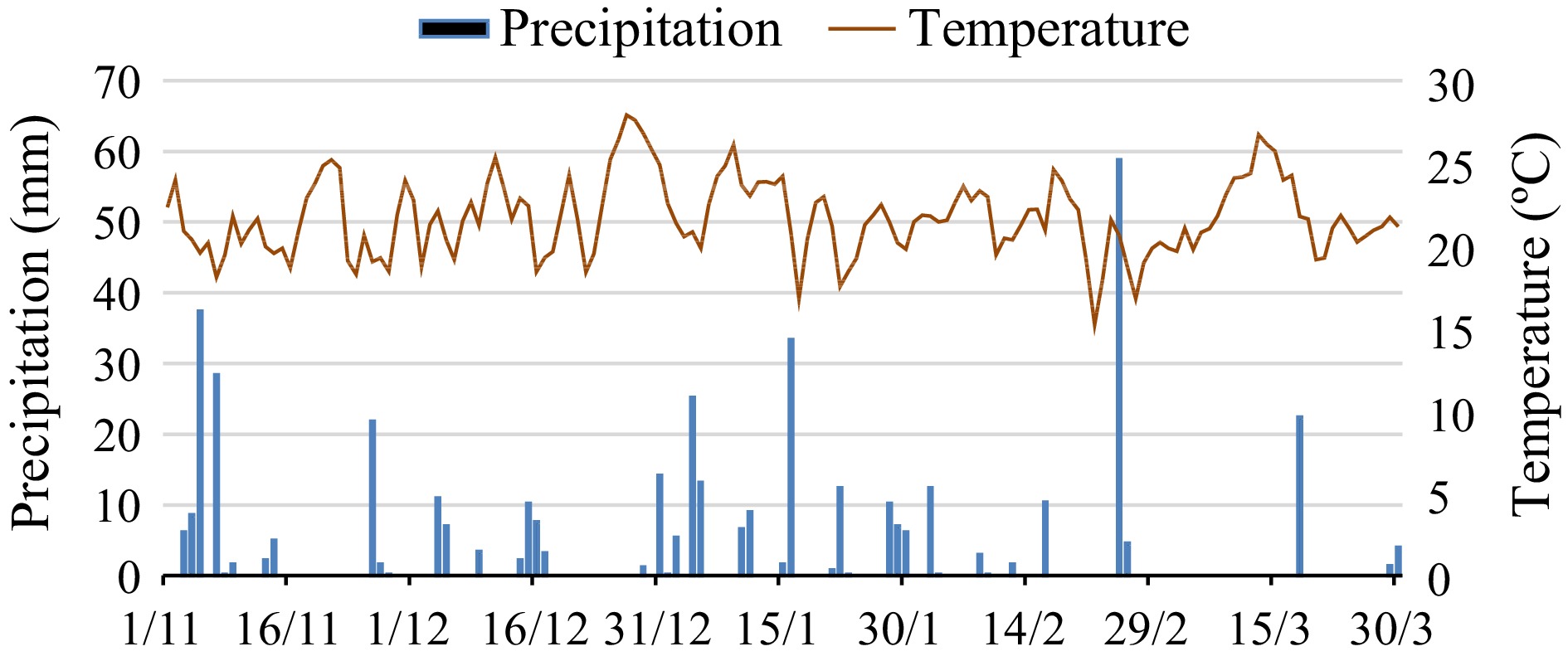
Figure 1.
Average temperature (°C) and monthly precipitation (mm) during the experimental period, from November 2019 to February 2020. Source: INMET[26].
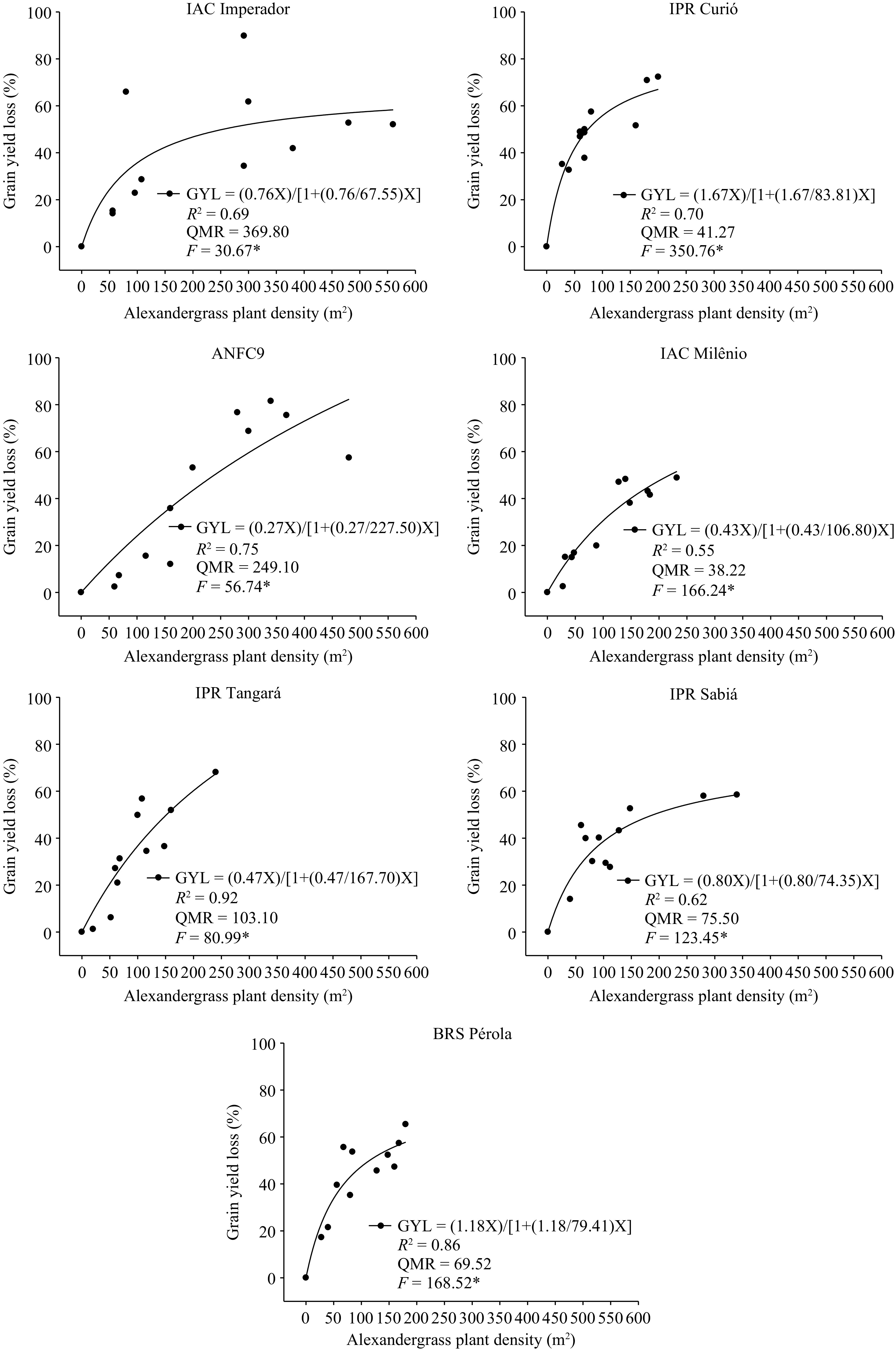
Figure 2.
Grain yield loss (GYL) of bean cultivars as a function of alexandergrass plant density 35 d after emergence. R2 = Coefficient of determination; MSR = mean square of residuals; * Significant at p ≤ 0.05.
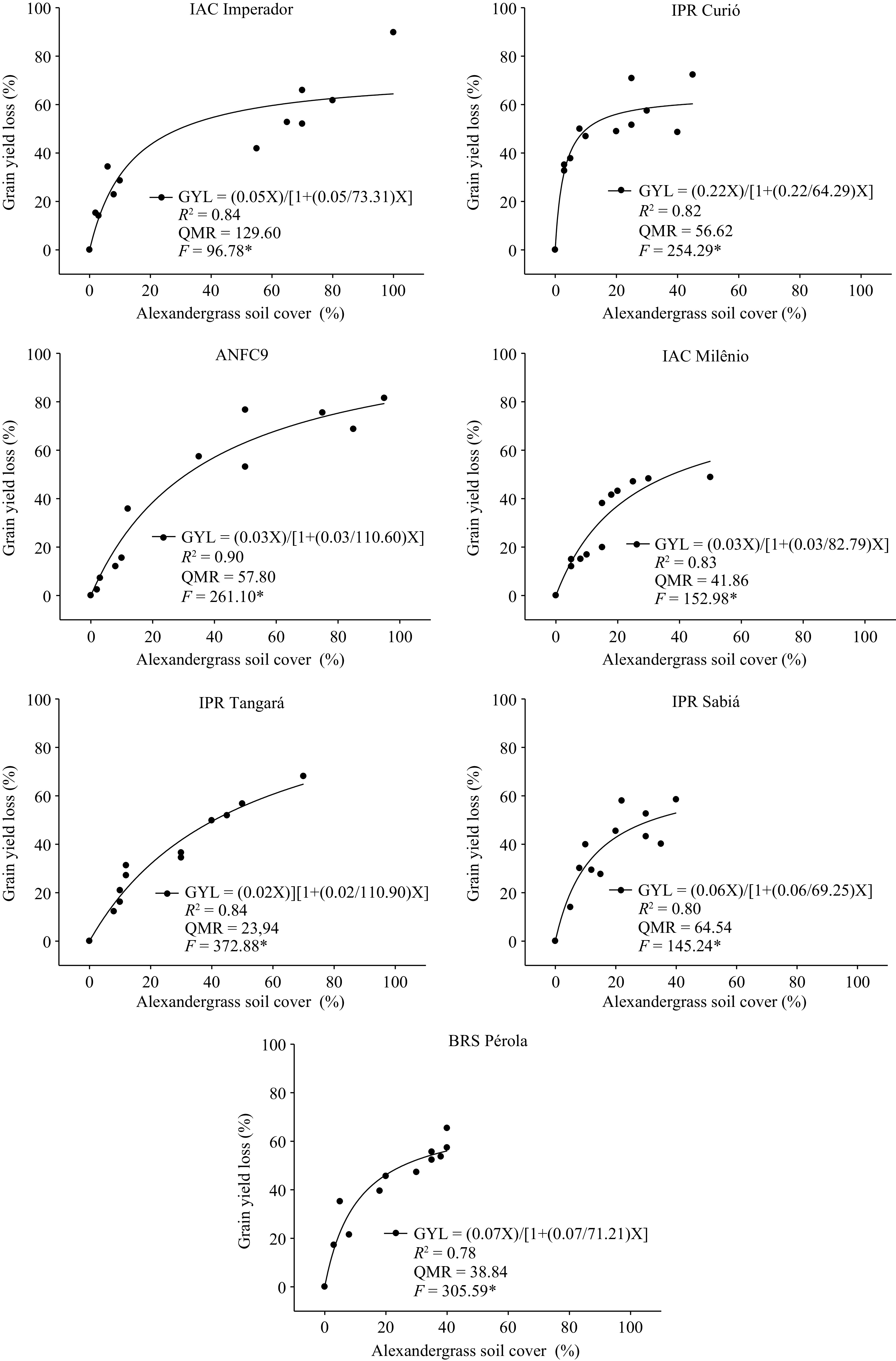
Figure 3.
Grain yield loss (GYL) of bean cultivars as a function of alexandergrass soil cover 35 d after emergence. R2 = Coefficient of determination; MSR = mean square of the residuals; * Significant at p ≤ 0.05.
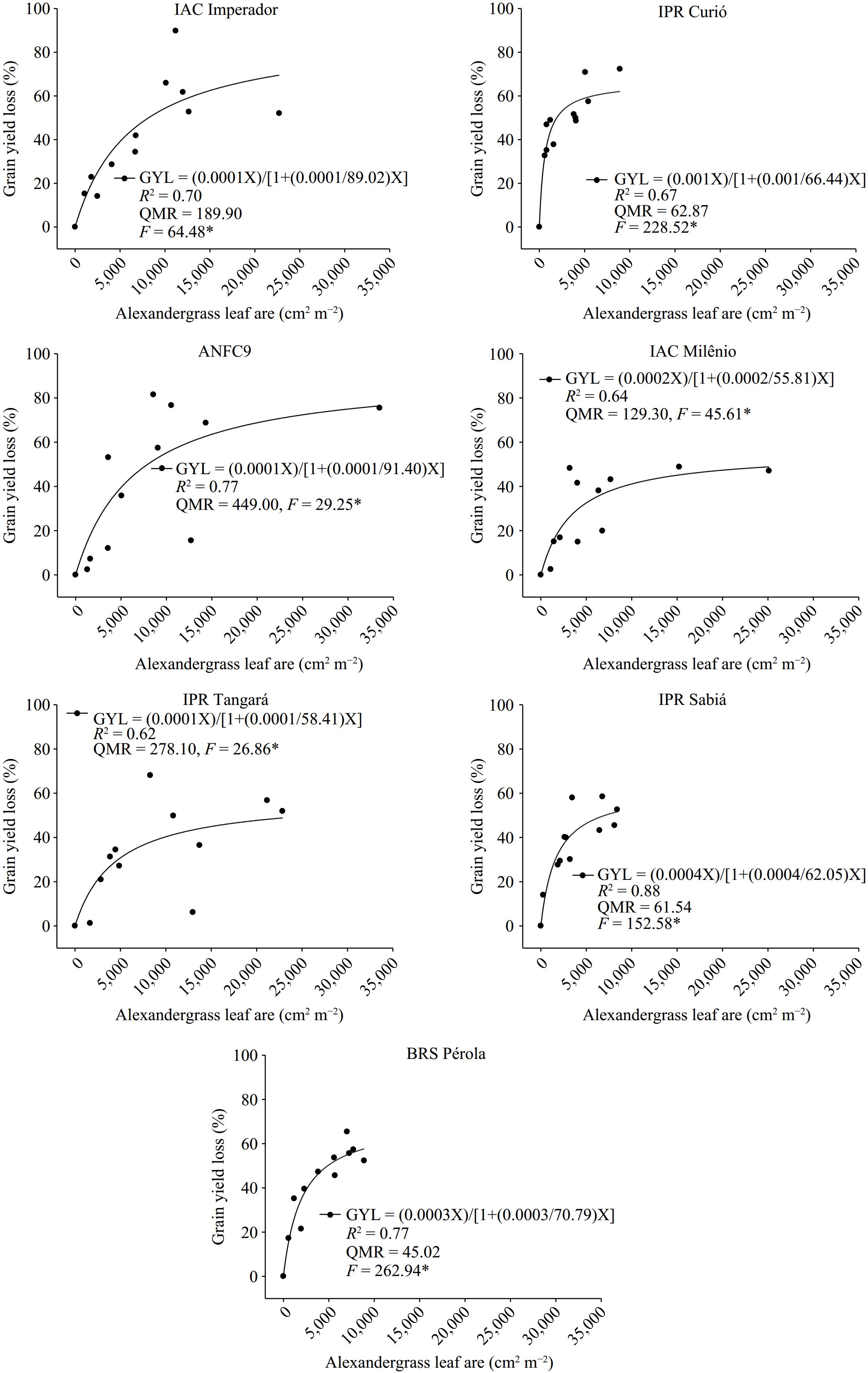
Figure 4.
Grain yield loss (GYL) of bean cultivars as a function of alexandergrass leaf area 35 d after emergence. R2 = Coefficient of determination; MSR = mean square of the residuals; * Significant at p ≤ 0.05.
Some physical and chemical properties of the soil were: pH in water 4.70; OM = 3.04%; P = 8.50 mg dm−3; K = 16.00 mg dm−3; Al3+ = 1.00 cmolc dm−3; Ca2+ = 5.10 cmolc dm−3; Mg2+ = 3.40 cmolc dm−3; CECeffective = 9.90 cmolc dm−3; CECpH7 = 18.60 cmolc dm−3; H+Al = 9.70 cmolc dm−3; base saturation = 48% and clay = 64%.
Experimental design
-
The cropping method chosen was the no-till system with black oat and vetch straw (4.50 t ha−1), with the plot dried with glyphosate (1,080 g ha−1) 15 d before sowing. The experimental design was completely randomized, with treatments consisting of seven carioca bean cultivars and 12 alexandergrass densities, as shown in Table 1.
Table 1. Bean cultivars and alexandergrass densities (plants m−2) used in the experiment.
Bean cultivar Alexandergrass density (m−2) IAC Imperador 0, 56, 56, 80, 96, 108, 292, 292, 300, 380, 480 and 560 IPR Curió 0, 28, 40, 60, 60, 68, 68, 68, 80, 160, 180 and 200 ANFC9 0, 60, 68, 116, 160, 160, 200, 280, 300, 340, 368 and 480 IAC Milênio 0, 28, 32, 44, 48, 88, 128, 140, 148, 180, 184 and 232 IPR Tangará 0, 20, 52, 60, 64, 68, 100, 108, 116, 148, 160 and 240 IPR Sabiá 0, 40, 60, 68, 80, 92, 104, 112, 128, 148, 280 and 340 BRS Pérola 0, 28, 40, 56, 68, 80, 84, 128, 148, 160, 168 and 180 Since the alexandergrass that infested the bean plant came as spontaneous vegetation from the soil seed bank in the area where the experiment was conducted, the establishment of density was not the same for all cultivars. The lack of uniformity is due to factors such as infestation, vigor, moisture, and dormancy of the weed seeds, among others, which prevent the establishment of the same number of plants per area (experimental unit). However, to maintain the natural growing conditions, it was decided not to thin out the different densities of alexandergrass between the cultivars. To maintain the natural situation in the field, the weed densities of the different cultivars were also not changed in other studies investigating similar situations to the present study[8,11,19,27,28]. The bean cultivars were selected because they are the most commonly grown in Brazil. Their characteristics, such as cycle, growth habit, and size are listed in Table 2.
Table 2. Cultivars, cycle, growth habit and architecture of the carioca beans used in the experiment.
Cultivar Cycle Growth habit Architecture IAC Imperador 70−75 d Determinate Erect IPR Curió 70 d Determinate Erect ANFC9 94 d Indeterminate Semi-erect IAC Milênio 90−95 d Indeterminate Semi-erect IPR Tangará 85−90 d Determinate Erect IPR Sabiá 87 d Indeterminate Erect BRS Pérola 90 d Indeterminate Semi-erect Each experimental unit (plot) consisted of an area of 15.0 m2 (3.0 m × 5.0 m), with sowing on 11/11/2019 in 6 rows 5 m long and 0.50 m apart. The sowing density of the bean cultivars was 14 seeds per linear meter or approximately 280,000 seeds ha−1.
The base fertilizer used was 387 kg ha−1 of formula 08-20-20 (N-P2O5-K2O) and 60 kg ha−1 of nitrogen in the form of urea (45% de N – 133 kg ha−1) when the bean cultivars were at the V3 stage, according to the chemical analysis of the soil and the expected grain yield of the crop[29].
Weed density was determined from the seed bank in the soil by applying the herbicide fluazifop-p-butyl (187.5 g ha−1) when the crop had three clovers and the weeds were between four leaves and one pollen. This timing was chosen because it is most suitable for post-emergence herbicide application. The alexandergrass weeds were protected with plastic cups to avoid injury from the herbicide. The remaining weeds in the untested experimental units were controlled by weeding. All other necessary management practices were carried out following the recommendations for the crop.
Variables analyzed
-
The quantification of plant density (PD), leaf area (LA), soil cover (SC) and shoot dry matter (DM) of alexandergrass was carried out 35 days after emergence (DAE). To determine the PD, the plants were counted in two plots of 0.25 m2 (0.5 m × 0.5 m) per experimental unit. Alexandergrass soil cover was assessed visually and individually by two evaluators using a percentage scale, with a score of zero corresponding to absence of SC and a score of 100 corresponding to complete soil cover. Quantification of LA of the competing plant was performed using a portable electronic LA integrator (model CI-203, CID Bio-Science, Camas, WA, USA), with all plants measured at 0.25 m−2 per plot. After LA determination, the plants were packed in kraft paper bags and placed in a forced air circulation oven at a temperature of 60 ± 5 °C until a constant mass was reached to determine the DM of the alexandergrass plants (g m−2).
Statistical analysis
-
To quantify the productivity of bean grains, the plants were harvested from a usable area of 6.0 m2 of each experimental unit when the moisture content was about 18%. After weighing the grains, their moisture content was determined and the weights were standardized to a content of 13%. Using the grain productivity data, the percentage losses compared to the plots without infestation (controls) were calculated using Eqn (1):
$\rm Loss \;({\text{%}}) = \left( \begin{gathered} \\ \\ \end{gathered} \right.\dfrac{{{\text{Ra}} - {\text{Rb}}}}{{{\text{Ra}}}}\left. \begin{gathered} \\ \\ \end{gathered} \right)\times 100 $ (1) where, Ra and Rb: crop productivity without or with the presence of, alexandergrass, respectively.
Before data analysis, the values for SC (%), LA (cm2) or DM (g m−2) were multiplied by 100, eliminating the use of the correction factor in the model[11,19,28].
The relationships between bean productivity loss percentages as a function of the explanatory variables were calculated separately for each cultivar, using the nonlinear regression model proposed by Cousens[30], derived from the rectangular hyperbolic shown in Eqn (2):
$\rm PL = \dfrac{{({\text{i}}\times{\text{X}})}}{{\left(1 + \left(\dfrac{{\text{i}}}{{\text{a}}}\right)\times{\text{X}}\right)}} $ (2) where, PL = productivity loss (%); X = plant density, soil cover, leaf area, or shoot dry matter of alexandergrass plants; i and a = productivity losses (%) per unit of alexandergrass plants when the value of the variables tends to zero and infinity, respectively. For the calculation procedure, the Gauss-Newton method was used, which estimates by successive interactions the values of the parameters for which the sum of the squares of the deviations of the observations are minimal as far as the fitted values are concerned[19]. The acceptance criterion for fitting the model to the data was based on the significance of the F-test (p ≤ 0.05), the highest value of the coefficient of determination (R2) and the lowest value of the mean square of the residuals (MSR).
The estimates of the parameter i from Equation[30] and the equation according to Lindquist & Kropff[31] (Eqn 3) were used to calculate the economic damage level (EDL):
$\rm EDL = \dfrac{{({\text{Cc}})}}{{\left({\rm R}\times {\rm P}\times\left(\dfrac{{\text{i}}}{{{\text{100}}}}\right)\times\left(\dfrac{{\text{H}}}{{{\text{100}}}}\right)\right)}} $ (3) where, EDL = economic damage level (plants m−2); Cc = control cost (herbicide and tractor-assisted soil application, in US dollars ha−1); R = bean grain productivity (kg ha−1); P = bean price (dollars kg−1 grains); i = loss of productivity (%) of carioca-type beans per unit of competing plants when plant density approaches zero, and H = herbicide efficiency (%).
For the variables Cc, R, P, and H (Eqn 3), three values occurring in the last 10 years were estimated. Thus, the average price (US
${\$} $ ${\$} $ -
The explanatory variables PD, LA, SC, and DM of alexandergrass evaluated for productivity loss of the carioca bean cultivars (IAC Imperador, IPR Curió, ANFC9, IAC Milênio, IPR Tangará, IPR Sabiá and BRS Pérola) showed significant statistical values (Figs 1−4).
For all bean cultivars studied, the rectangular hyperbolic data adequately fitted the model, with an average R2 value for the variables PD, SC, LA, and DM of more than 0.72 and a low MSR value, which characterizes a good fit of the model to the data. According to Cargnelutti Filho & Storck[33], when working with genetic variation, the effect of cultivars, and the heritability of maize hybrids, R2 values between 0.57 and 0.66 were found to be moderate to good, partially confirming the results found in this study. Galon et al.[11], when studying the competition of six black bean cultivars, infested with different densities of hairy beggarticks (Bidens pilosa), found average R2 adjustments of 0.72, which corresponds to those observed in the present study.
Competitiveness among bean cultivars and alexandergrass
-
The parameter i is considered an index to compare the relative competitiveness between species, and the lower the values, the more competitive the crop[11,19,23]. For the explanatory variables PD, SC, LA, and DM, it was found that the cultivars ANFC9, IAC Milênio, and IPR Tangará had the lowest average i-values and were the most competitive (Figs 1−4). The least competitive cultivars were IPR Curió and BRS Perola. The cultivars IAC Imperador and IPR Sabiá were at an intermediate level of competitiveness, i.e. between the highest and lowest values. This fact is probably due to the genetic differences that exist between the bean cultivars, such as size, plant architecture, branching, growth cycle and growth habit, leaf area index, root volume and density, growth speed, etc., which cause different effects of the materials in the presence of weeds[2,6,34]. Other studies have also reported that the competitive ability of bean cultivars in the presence of weeds belonging to the monocotyledonous or dicotyledonous classes are different, which researchers attribute to the different morphophysiological characteristics of the cultivars[2,8,14,20].
When comparing the bean cultivars IAC Imperador, IPR Curió, ANFC9, IAC Milênio, IPR Tangará, IPR Sabiá and BRS Pérola for PD based on unit loss (i), yield losses of 0.76%, 1.67%, 0.27%, 0.43%, 0.47%, 0.80% and 1.18% were observed, respectively (Fig. 2). Cultivars with a lower number of branches and a more upright shape have a lower soil cover capacity and consequently a lower competitive ability against weeds. This fact is related to and dependent on the genetic characteristics of each cultivar, as previously described and also observed by other researchers working with bean crops[2,11,34]. Competition from genetic material is becoming a potential strategy for the integrated management of weeds in the current control programs[12,13,35], and so there is an opportunity to reduce the use of herbicides, for example, by reducing cases of resistance, the cost of cultivation, environmental and human pollution or even the production of healthier food. In the case of beans, this fact is important because it is already known that alexandergrass is resistant to herbicides that inhibit the enzyme acetyl-coenzyme A acetocarboxylase – ACCase[36], the main class of products used to control it, so this crop management can achieve better coexistence between the crop and the weed species that can attack it.
The results show that the productivity losses of the bean cultivars were higher for the IPR Curió and BRS Pérola cultivars and lower for all others, with the density of 100 plants m−2 of alexandergrass leading to losses of more than 47% (Fig. 1). According to Barroso et al.[20], characteristics such as growth habit, development cycle, and number of branches, among others, influence the competitiveness between different bean cultivars in competition with weeds. Kalsin & Vidal[8], found a reduction in grain productivity of bean cultivars by more than 90% when infested by high densities of alexandergrass, which partly agrees with the results observed in this study. In addition, the grain productivity of bean cultivars decreased approximately sevenfold when the density of alexandergrass plants was increased from 5 to 50 plants m−2 (Fig. 1). This shows that alexandergrass is a highly competitive species that can cause high losses in grain productivity of bean crops in the absence of management, as also found by Teixeira et al.[34].
Alexandergrass caused average productivity losses of 12.83 and 76.74% in the bean cultivars with the lowest and highest plant densities (20 and 560 plants m−2, respectively) (Fig. 1). It is noteworthy that high densities of alexandergrass are common in summer crops, so control of this weed species is important due to its competitive ability and the high grain productivity losses it causes when it attacks bean crops[8].
The loss of grain productivity of bean cultivars as a function of the percentage of SC is similar to that of PD (Fig. 1), i.e. with increasing soil cover by the weed, there were greater losses at harvest. The average productivity loss was 97% when comparing a 10% SC with a 20% alexandergrass (Fig. 3). This shows that an increase in alexandergrass cover, even if it is 10%, leads to an increase in average grain productivity losses of bean cultivars by almost 50%. Alexandergrass stands out as a very competitive weed when it has infested summer-sown agricultural crops, in practically all Brazilian crops. This is due to its seed dormancy, its large seed bank in the soil, its occurrence in high densities and dispersal, its abundant sprouting, its release of allelopathic substances and its C4 metabolism, which is very efficient in the utilization of environmental resources (water, light and nutrients), as also reported by Kalsing & Vidal[8] and Franceschetti et al.[3].
The average productivity loss of the studied bean cultivars for LA (10,000 cm2 m−2) was 2.89%, with IPR Curió showing the highest loss (8.69%) and the cultivars IAC Imperador, ANFC9 and IPR Tangará the lowest (0.99%) compared to the others (Fig. 3). The increase in alexandergrass LA from 10,000 to 20,000 cm2 m−2 increased the average losses in bean grain yield by 86% (Fig. 3). It can be observed that the degree of competition of alexandergrass with beans is influenced by LA, i.e. the more LA the weed has per relative unit, the more competitive it is against the crop. The results of this study confirm the findings of Galon et al.[11], who also found that hairy beggarticks causes high losses in bean grain yield due to its stronger development and growth. Beans are one of the crops that provide little shade to the soil and therefore have low competitive ability and a strong influence of weeds[20]. Parreira et al.[2] state that crops have a lower competitive ability due to the improvement process they have undergone and consequently have a lower tolerance to the effects of competition, as is the case with beans, where alexandergrass has a highly competitive ability when it has infested the crop.
At an accumulation of 50 g m−2 DM, alexandergrass caused a reduction in the grain productivity of beans: 0.99%, 4.25%, 1.47%, 1.46%, 0.99%, 1.48% and 1.95% for the cultivars IAC Imperador, IPR Curió, ANFC9, IAC Milênio, IPR Tangará, IPR Sabiá and BRS Pérola (Fig. 5). By increasing the DM accumulation from 25 to 50 g m−2, alexandergrass caused an average loss of 98% in grain productivity in the bean cultivars studied, i.e. for every 1 g increase in DM of the competitor in this analyzed area, there was a 4% decrease in grain productivity. In this way, it can be concluded that with the increase in the accumulation of DM in alexandergrass, i.e. with the growth and development of the weed plant, it begins to dominate the environment and compete more intensely for environmental resources and consequently with the bean crop, making the weed control necessary. Cury et al.[37] reported that alexandergrass and Amaranthus spinosus (spiny pigweed) have a great aggressive potential when competing with bean plants, which negatively affects the accumulation and distribution of dry matter in all vegetative elements of the crop. It is also worth noting that weeds in agricultural areas have a greater competitiveness against crops when they occur in high density and not individually[11,21].
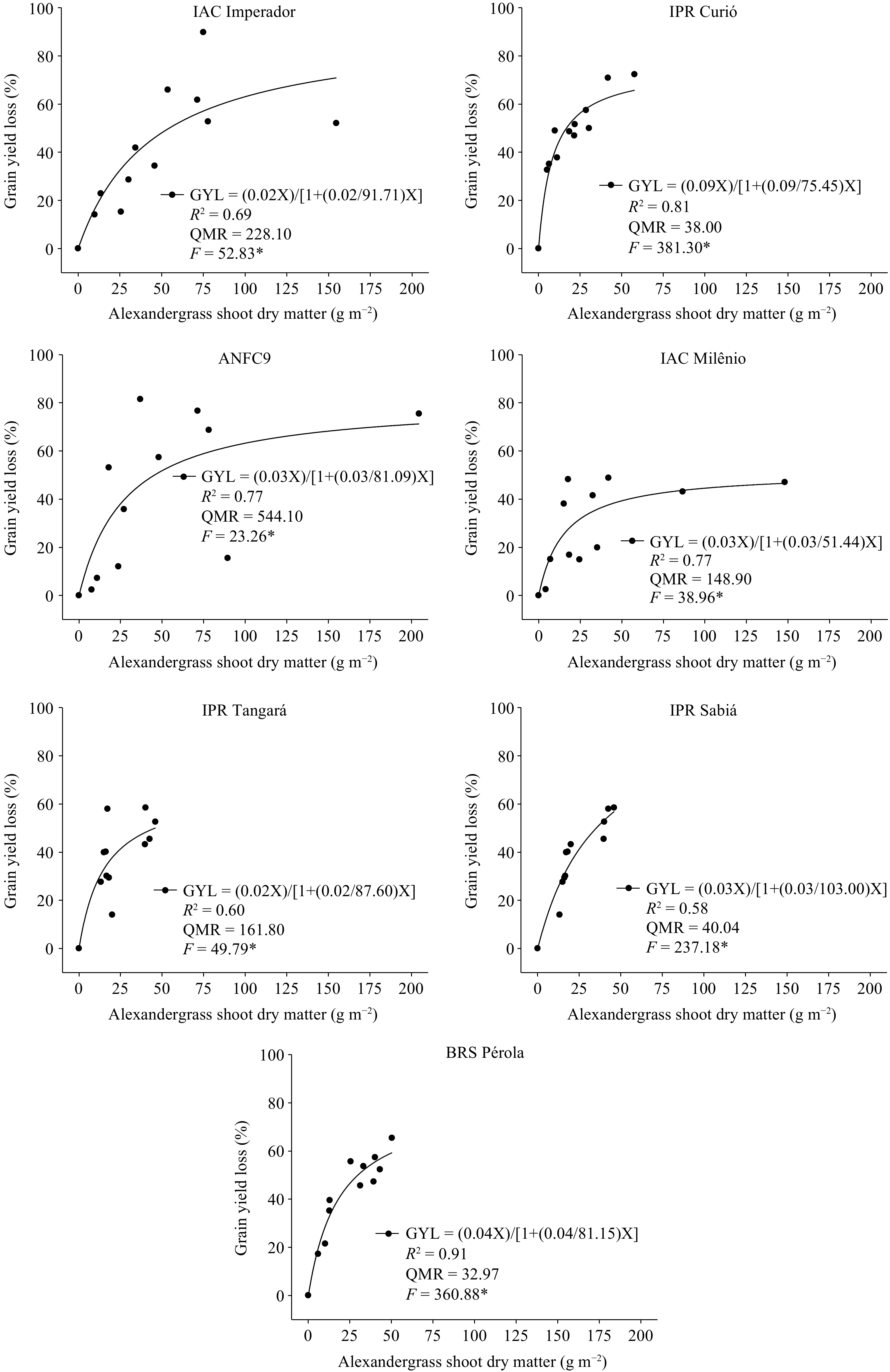
Figure 5.
Grain yield loss (GYL) of bean cultivars as a function of alexandergrass shoot dry matter 35 d after emergence. R2 = Coefficient of determination; MSR = mean square of the residuals; * Significant at p ≤ 0.05.
Considering PD, SC, LA, and DM of alexandergrass, it was found that the bean cultivars with the highest competitiveness were IAC Imperador, ANFC9, IAC Milênio and IPR Tangará, while the others had the lowest competitiveness (IPR Curió, IPR Sabiá and BRS Pérola). The cultivars studied in this experiment have different characteristics such as growth habits, development cycle and number of branches, which, according to Barroso et al.[20], differentiate them in terms of their competitiveness against weeds. Weeds have a negative effect on the development of bean crops, with alexandergrass being highly competitive and causing damage to the crops it attacks[8,18,34].
In the present study, alexandergrass was found to have a high ability to attack the bean crop, as there was a high loss of grain productivity in the crop with the increase in PD, SC, LA and DM of the competitor (Figs 2−5). Cury et al.[6] observed that the spiny pigweed and alexandergrass in coexistence with bean plants affected the growth and accumulation of nutrients in the crop, which partly agrees with the results of the present study.
Since the parameter i is an index used to compare the relative competitiveness between species[19], different values were observed for the bean cultivars in the explanatory variables tested (Figs 2−5). The comparison between cultivars considering the parameter i on the average of the four explanatory variables (PD, SC, LA, or DM) showed that, in general, the ranking in terms of competitiveness was: ANFC9 > IAC Milênio > IPR Tangará > IAC Imperador > IPR Sabiá > BRS Pérola > IPR Curió (Figs 2−5). As already described, this fact is related to the genetic differences between the materials used in the present study. This result is confirmed by the observations of Kalsing & Vidal[8], who found that bean cultivars responded differently to the parameters evaluated when affected by the density of alexandergrass.
The estimates of parameter a considering the variables PD, SC, LA, and DM were mostly below 100%, except in six situations where the values were above 100% (Figs 2−5). Although values above 100% occurred in six situations, it can be said that it is possible to adequately simulate the maximum productivity losses in bean grains with the alexandergrass densities used. Productivity losses of more than 100% could be due to the fact that higher alexandergrass densities were not sufficient to adequately estimate the maximum productivity loss of bean grains, as also reported by Agostinetto et al.[19] when studying rice in competition with barnyardgrass.
Similar to the present study, Galon et al.[11] observed maximum losses of less than 100% for the variables PD, SC, LA and DM when evaluating bean cultivars infested with densities of hairy beggarticks, confirming the results of our study. It should be noted that the greater the production potential of the crops and the better the soil fertility, water availability, and light conditions, the lower the daily percentage losses due to a particular weed species[13,19].
The comparison between the explanatory variables for all bean cultivars showed a better fit to the model: SC > PD > DM > LA, considering the highest mean values of R2 and F and the lowest mean values of MSR (Figs 2−5), which shows that SC can be used to estimate the losses in grain yield of beans. This fact was also observed by Galon et al.[28] when they evaluated the competition of oilseed rape cultivars with weeds; they found that the loss in grain productivity can be estimated using the SC of ryegrass.
Economic damage level (EDL) among bean cultivars and alexandergrass
-
For the simulation of economic damage level – EDL – values, the explanatory PD of alexandergrass was used, as it is the most commonly used in experiments with this objective[11,19]. It should also be noted that this variable has some advantages over the others, such as simplicity, speed, precision, and low cost of determination.
Considering the average productivity of carioca beans of about 1,672 kg ha−1, the average price of a 60 kg bag worth US
${\$} $ ${\$} $ ${\$} $ 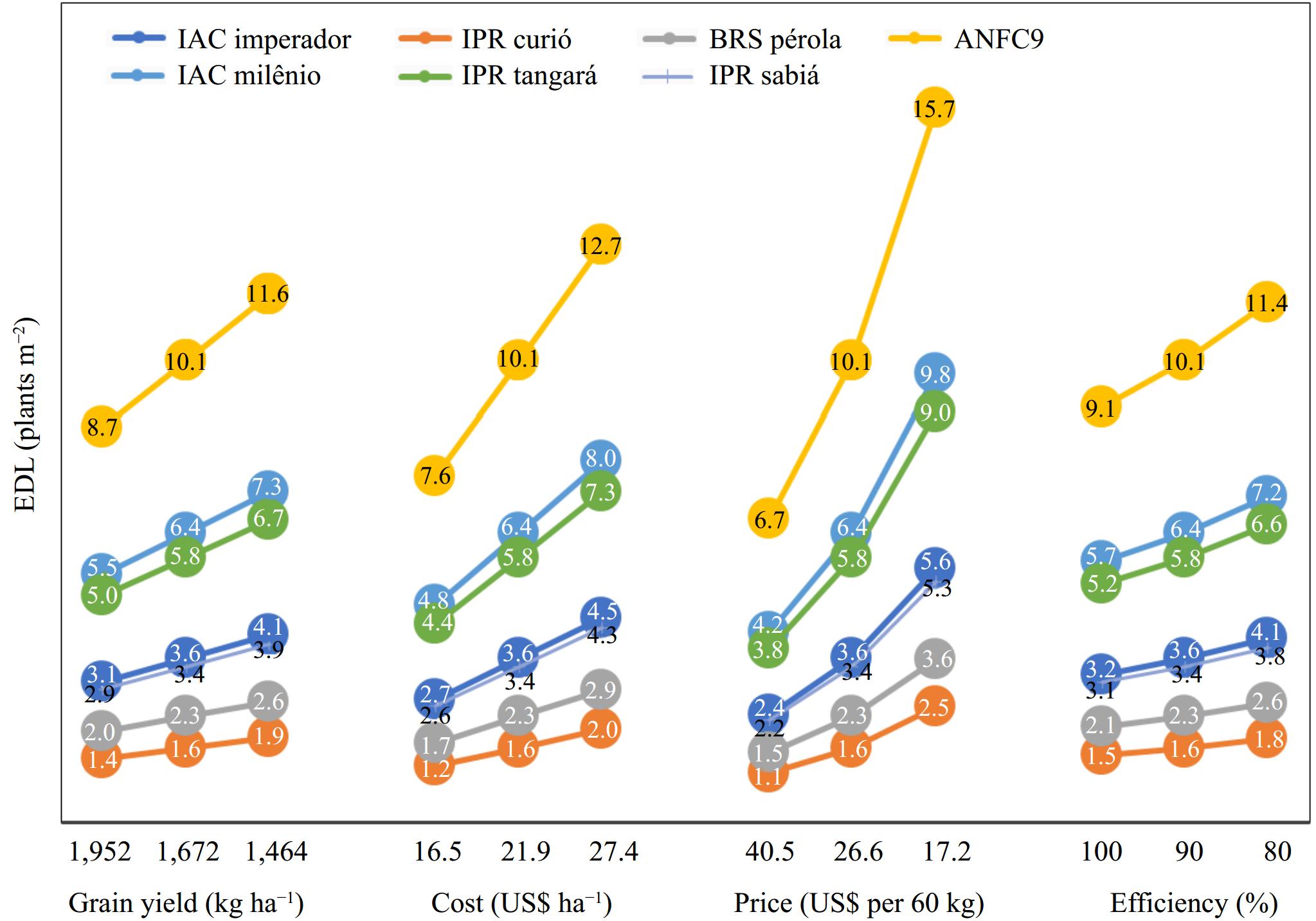
Figure 6.
Economic damage level (EDL) of alexandergrass densities in bean cultivars as a function of grain yield, cost control, bean price and herbicide efficiency.
Success in implementing management systems for alexandergrass infestation of bean crops may result from determining the density that exceeds the EDL. The lowest EDL caused by alexandergrass density for the seven bean cultivars as a function of grain productivity, control costs, bean price, and herbicide efficacy was observed in IPR Curió with an average value of 1.65 plants m−2 (Fig. 6). Using the same criteria, the bean cultivars BRS Pérola, IPR Sabiá, IAC Imperador, IPR Tangará, IAC Milênio and ANFC9 were found to have an EDL of 2.35, 3.48, 3.68, 5.93, 6.51, and 10.33 alexandergrass plants m−2, respectively. It was found that the cultivars IPR Tangará, IAC Milênio, and ANFC9 had the highest EDL values in all simulations performed, ranging from 3.8 to 15.70 plants m−2. The lowest EDL values were found for the cultivars IPR Curió and BRS Pérola, with variations of 1.2 to 2.9 plants m−2. The observed differences in EDL are as previously reported, due to the different genetic characteristics of the cultivars, as reported for bean cultivars in competition with alexandergrass[7] and in competition with hairy beggarticks[11].
The lowest EDL values for grain productivity were obtained in the cultivars IPR Curió and BRS Pérola, probably due to the fact that these cultivars have a shorter cycle, a lower leaf area index and a lower plant height, which allows greater light incidence and, consequently, greater development of the alexandergrass. The greater incidence of light between the rows of plants give the alexandergrass, as a C4 metabolic type, a competitive advantage over the bean plant, which belongs to the C3 type.
Grain productivity, control costs, price per bean bag and herbicide efficiency influenced the EDL of alexandergrass in the crop. When bean cultivars decreased grain productivity by 448 kg ha−1 (from 1,952 to 1,461 kg ha−1), the alexandergrass density required to achieve EDL increased by about 25% on average across all bean cultivars (Fig. 6). Therefore, it can be observed that the expected increase in crop productivity is less influenced by competition from weeds, which was also reported by Galon et al.[11] when evaluating bean cultivars in the presence of hairy beggarticks. An increase in control cost of US
${\$} $ ${\$} $ ${\$} $ ${\$} $ ${\$} $ ${\$} $ When the herbicide efficacy was reduced by 20%, i.e. from 100% to 80%, the alexandergrass density required to reach the EDL increased by about 25% in the cultivars IAC Imperador, IPR Curió, ANFC9, IAC Milênio, IPR Tangará, IPR Sabiá and BRS Pérola (Fig. 6). Galon et al.[11] also observed an increase in the density of hairy beggarticks of more than 13% when infesting the bean cultivars IPR Uirapuru, BRS Supremo, BRS Campeiro, Fepagro 26, BRS Esplendor, and IPR Tuiuiú until the EDL was reached.
Variations between the highest and lowest grain productivity, control cost, price per bag (60 kg), and herbicide effect influenced the average of the seven bean genotypes (IAC Imperador, IPR Curió, ANFC9, IAC Milênio, IPR Tangará, IPR Sabiá and BRS Pérola) with variations of 24.93%, 40.05%, 57.48%, and 20.27%, respectively (Fig. 6). These data partially confirm the results of Vidal et al.[27] in the evaluation of the competitiveness and EDL of alexandergrass and white edge morning-glory (Ipomoea nil) infesting black and carioca bean cultivars.
The cultivars IAC Imperador, IPR Curió, ANFC9, IAC Milênio, IPR Tangará, IPR Sabiá, and BRS Pérola caused an average EDL deviation of about 36% on average of the variables (grain productivity, control costs, bean price, and herbicide efficiency) in the presence of the alexandergrass (Fig. 6). Other studies showed similar results to the present study in carioca beans infested with alexandergrass[8], and in black beans infested with hairy beggarticks[11].
The cultivars ANFC9, IAC Milênio, and IPR Tangará showed the best results in the calculation of EDL considering grain productivity, i.e. they can coexist with a higher number of alexandergrass plants than IAC Imperador, IPR Curió, IPR Sabiá and BRS Pérola (Fig. 6). Thus, it was found that the greater the production potential of the plant, the lower the plant density required to exceed the EDL values. Studies have shown that the greater the production potential of bean cultivars, the lower the EDL values in coexistence with different weed species[21,27].
On average for all cultivars and when comparing the lowest with the highest grain productivity, a difference in EDL of around 25% was observed (Fig. 6). The higher the production potential of the bean cultivars, the lower the density of alexandergrass plants required to overcome the EDL, making weed control measures worthwhile. The EDL of alexandergrass or white edge morning-glory[27] or hairy beggarticks[11], weeds in bean cultivars, increases as the price decreases, increasing the control costs and the price of the beans.
When looking at the costs of controlling alexandergrass for all bean cultivars, it was found that the minimum costs were about 40% below the maximum costs (Fig. 6). Thus, the higher the cost of the control method, the higher the EDL and the more alexandergrass plants m−2 are needed to justify the control measures. Galon et al.[11] also found differences of 40% when comparing the maximum and minimum costs of infesting the bean cultivars IPR Uirapuru, BRS Supremo, BRS Campeiro, Fepagro 26, BRS Esplendor and IPR Tuiuiú with hairy beggarticks.
For the cultivars IAC Imperador, IPR Curió, ANFC9, IAC Milênio, IPR Tangará, IPR Sabiá and BRS Pérola, an increase in the EDL value of around 58% was observed when comparing the highest and lowest price paid per bag of beans (Fig. 6). The lower the price paid per bag of beans, the higher the density of alexandergrass required to exceed the EDL value and thus compensate for the use of a control method. When the black-type (IPR Graúna) and carioca-type (UFT-06) bean cultivars competed with alexandergrass and white edge morning-glory, a similar variation was observed when comparing the highest and lowest price paid for a bag of beans[27] as in the present study.
Regarding the efficiency of the chemical control method with herbicides, it was found that the average efficiency (90%) compared to the lowest (80%) or highest (100%) value showed an average variation of 11.5% of the EDL (Fig. 6). The higher the herbicide efficiency, the lower the EDL, i.e. the fewer alexandergrass plants m−2 are required to carry out a control measure. Comparing the herbicide efficiency of 90% with 80% and 100% in bean cultivars[11] in the presence of hairy beggarticks, there is a difference of almost 8 and 13%, respectively, which is comparable to the results of the present study.
EDLs varied by bean cultivar with higher values for ANFC9 > IAC Milênio > IPR Tangará > IAC Imperador > IPR Sabiá > BRS Peróla > IPR Curió (Fig. 6). Other researchers also found differences between cultivars and weed species in terms of competition with bean crops[8,11,27], confirming the results of the present study. As previously reported, the differences in the competitive ability between species can be attributed to bean genetics itself, management, soil and climatic conditions, allelopathic effects, species, density, and distribution of weeds in competition[11,21,38].
It is noteworthy that advanced weed control methods are increasingly needed to achieve better productivity, higher profitability, and the production of healthier food with less pesticide residues, especially herbicides[39]. The use of EDL as a weed control agent must be associated with good agricultural management practices in beans, as its use is only justified in crops that apply crop rotation, appropriate crop placement, the use of more competitive varieties and recommended growing areas, appropriate sowing times, soil fertility correction, etc.
-
The rectangular hyperbolic model adequately estimates bean grain productivity losses in the presence of alexandergrass. The soil cover variable best fitted the rectangular hyperbolic model and adequately estimated bean grain productivity losses due to alexandergrass. The cultivars ANFC9, IAC Milênio, and IPR Tangará were the most competitive, and IAC Imperador, IPR Curió, IPR Sabiá, and BRS Pérola are the least competitive in the presence of alexandergrass. The highest economic damage was observed in the cultivars ANFC9, IAC Milênio, and IPR Tangará, which ranged between 3.80 and 15.70 plants m−2 alexandergrass. The cultivars IAC Imperador, IPR Curió, IPR Sabiá and BRS Pérola showed the lowest economic damage with 1.10 to 5.60 plants m−2 of alexandergrass. The economic damage decreases with the increase in grain productivity, the price of a bag of beans, the effectiveness of the herbicide, and the reduction in the cost of alexandergrass control, which justifies the application of control measures at lower densities of the weed.
-
The authors confirm contribution to the paper as follows: study conception and design: Galon L, Perin GF, Trezzi MM; data collection: Favretto EL, Cavaletti DC, Henz Neto OD; analysis and interpretation of results: Brunetto L, Galon L, Perin GF; draft manuscript preparation: Favretto EL, Amarante L, Brunetto L. All authors reviewed the results and approved the final version of the manuscript.
-
The data that support the findings of this study are available from the corresponding author (Galon L) upon reasonable request.
National Council for Scientific and Technological Development (CNPq; process number 306927/2019-5 and 403457/2023-8), the Foundation for Research Support in Rio Grande do Sul (FAPERGS; process number 19/2551-0000874-0) and Federal University of Fronteira Sul (UFFS; process number - 2020-0163).
-
The authors declare that they have no conflict of interest.
- Copyright: © 2024 by the author(s). Published by Maximum Academic Press, Fayetteville, GA. This article is an open access article distributed under Creative Commons Attribution License (CC BY 4.0), visit https://creativecommons.org/licenses/by/4.0/.
-
About this article
Cite this article
Galon L, Favretto EL, Cavaletti DC, Henz Neto OD, Amarante Ld, et al. 2024. Interference and economic damage level of alexandergrass on carioca type beans. Technology in Agronomy 4: e022 doi: 10.48130/tia-0024-0020
Interference and economic damage level of alexandergrass on carioca type beans
- Received: 27 December 2023
- Revised: 27 May 2024
- Accepted: 29 May 2024
- Published online: 12 August 2024
Abstract: Determining the competitive ability of bean cultivars and the economic damage level (EDL) caused by alexandergrass is important for the implementation of integrated weed management. This work aimed to evaluate the interference of alexandergrass and determine the level of economic damage when it competes with seven carioca-type bean cultivars. The experiment was conducted in a completely randomized experimental design, with treatments consisting of the carioca bean varieties IAC Imperador, IPR Curió, ANFC9, IAC Milênio, IPR Tangará, IPR Sabiá, and BRS Pérola and 12 alexandergrass densities for each cultivar, ranging from 0 to 560 plants m−2. Plant density, leaf area, soil cover, and shoot dry matter of alexandergrass were evaluated 35 d after emergence. The variables alexandergrass plant density, grain productivity, control costs, bean price, and herbicide efficiency were used to estimate EDL. The cultivars ANFC9, IAC Milênio, and IPR Tangará were the most competitive, and IAC Imperador, IPR Curió, IPR Sabiá, and BRS Pérola the least competitive against alexandergrass. The highest EDL values were observed in the cultivars ANFC9, IAC Milênio and IPR Tangará, which ranged between 3.80 and 15.70 plants m−2 of alexandergrass. The cultivars IAC Imperador, IPR Curió, IPR Sabiá, and BRS Pérola showed the lowest economic damage with 1.10 to 5.60 plants m−2 of alexandergrass.
-
Key words:
- Phaseolus vulgaris /
- Urochloa plantaginea /
- Competitive interaction


